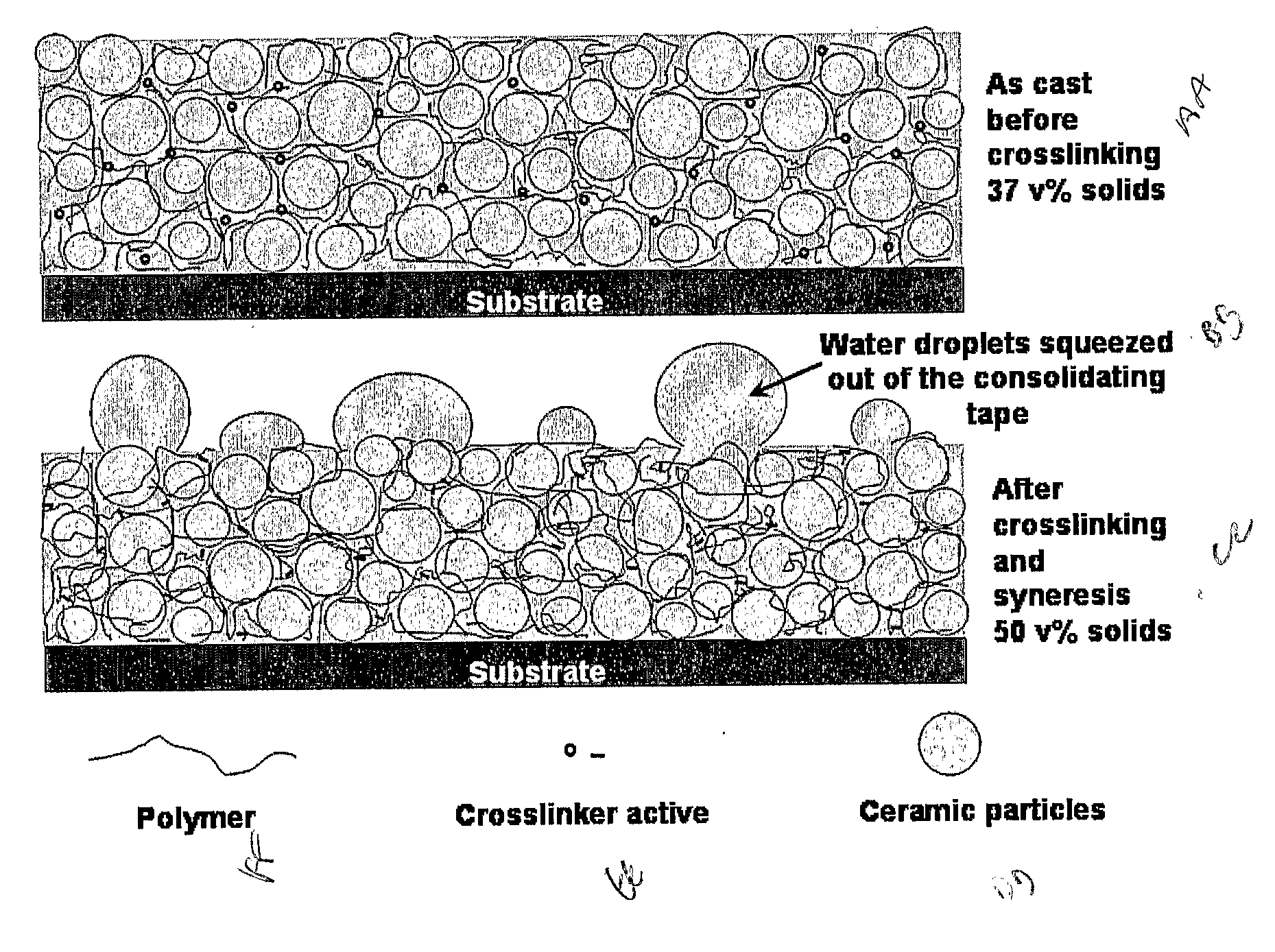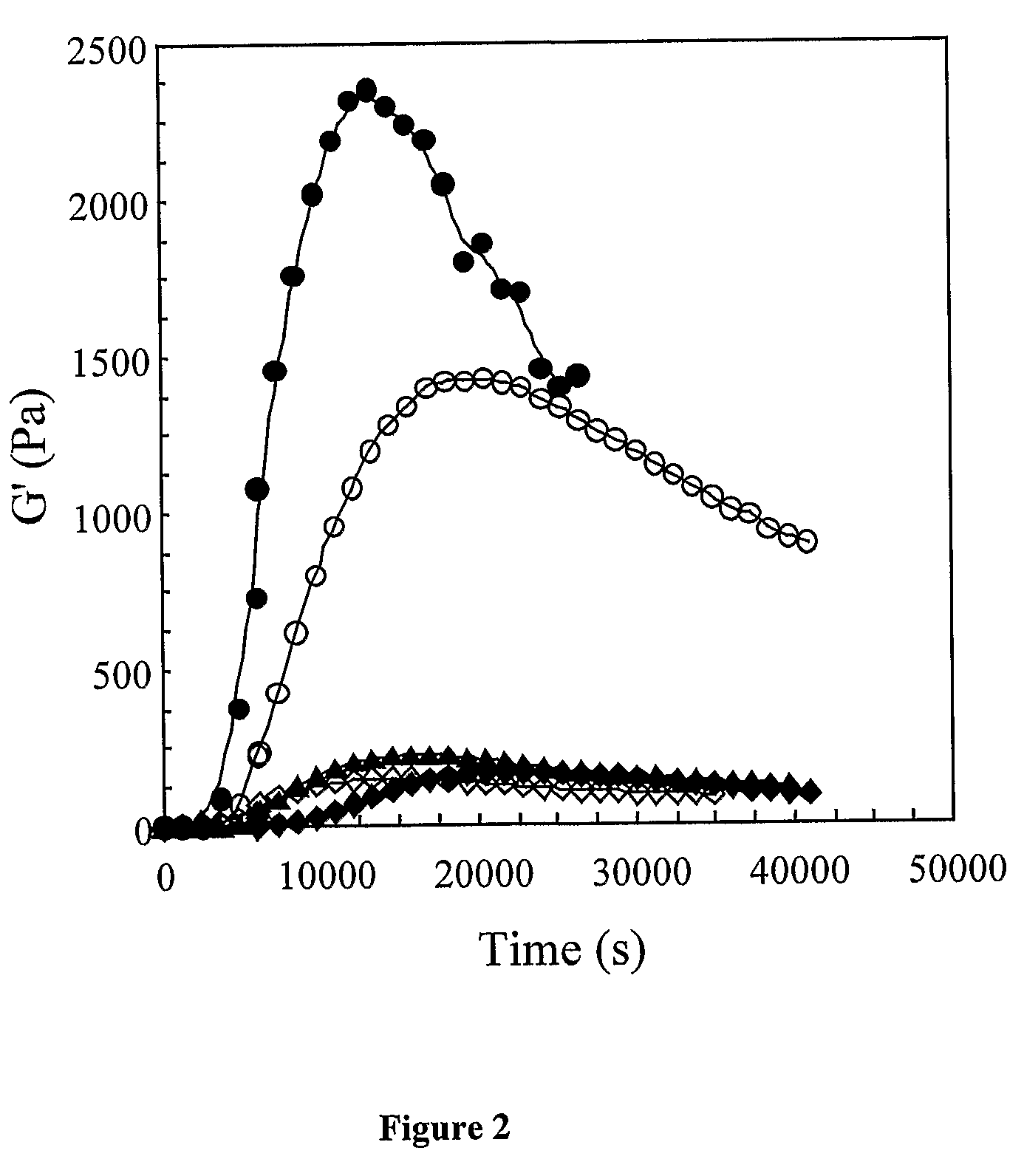Ceramic and Metallic Components and Methods for Their Production from Flexible Gelled Materials
a technology of flexible gelled materials and ceramics, applied in the field of forming ceramic and metallic components, can solve the problems of high energy consumption, high energy consumption, and inability to cast ceramics from the molten state, and achieve the effects of increasing the degree of crosslinking of biopolymers, increasing viscosity, and increasing the viscosity
- Summary
- Abstract
- Description
- Claims
- Application Information
AI Technical Summary
Benefits of technology
Problems solved by technology
Method used
Image
Examples
example 1
Gelation of Chitosan with DHF
[0133]The gelation by cross-linking of an aqueous chitosan / 2,5-dimethoxy-2,5-dihydrofuran (DHF) system has been rheologically examined as a function of temperature (40-98° C.), pH (0.9-3.9) and DHF concentration (1.0-10×10−2 mole dm 3). The resulting findings can be summarised as follows:
[0134](1) The delay time prior to gelation decreases, and the rate of gelation increases as a function of rising temperature. The shear modulus versus time behaviour indicates that the mechanical strength of the gel initially increases then diminishes. These findings can be justified in terms of the competition between a butenedial-driven cross-linking reaction and gradual protolytic depolymerisation of chitosan. (See FIG. 1.)
[0135](2) At pH≦2.1, both the rate of gelation and the magnitude of the maximum shear modulus increase as a function of decreasing pH. In addition, the time at which the maximum shear modulus occurs is lower for the more acidic chitosan / DHF solution...
example 2
Change in Rheological Behaviour of Suspension During Gelation
[0137]A high purity α-alumina powder (AKP-30) was obtained from Sumitomo Corporation (Japan). It possessed a BET surface area of 7 m2 gel, a mean particle diameter of 0.3 μm and a density of 3.97 g cm−3. A high molecular weight chitosan was purchased from Fluka BioChimika (Switzerland). It had a molecular weight of 2×106 and a degree of de-acetylation (DD) of approximately 87 percent (Berthold, et al. 1996). The DD is an indicator of the proportion of hydrophilic (de-acylated) amine groups to hydrophobic acetamide moieties on the chitosan chains, with a high DD favouring good aqueous solubility to form low viscosity solutions. Cis / trans 2,5-dimethoxy-2,5-dihydrofuran (DHF) was obtained from Tokyo Kasei. The pH of all solutions and suspensions was adjusted using analytical grade hydrochloric acid and sodium hydroxide (both from Ajax Chemicals, Australia). All water used in this study was of Milli-Q grade (conductivity ≈10−6...
example 3
Analysis of Viscosity Variation with pH
[0143]A suspension was prepared containing 45 vol % alumina, a solution chitosan concentration of 1.0 wt %, as described in Example 2. The viscosity of the suspension was measured using the ‘Viscometry’ function of the Stresstech rheometer, again in a cone-and-plate geometry as in Example 2. As all viscometry measurements were performed at 20° C., evaporation was not found to affect the results obtained over the experimental time-frame. The use of silicone oil was therefore not deemed to be necessary. FIG. 4 is a plot of viscosity verses shear rate for suspensions at 20° C. at various pH values from 1.1 to 4.5. This figure indicates that at room temperature the suspension is slightly shear thinning but the viscosity is relatively low. The behaviour of the suspension is liquid-like and it is pourable and injectable.
[0144]One hundred millimole dm−3 (mM) DHF was added to the suspension. The suspension was allowed to mix for between 2 and 8 hours. ...
PUM
| Property | Measurement | Unit |
|---|---|---|
| Temperature | aaaaa | aaaaa |
| Flexibility | aaaaa | aaaaa |
| Metallic bond | aaaaa | aaaaa |
Abstract
Description
Claims
Application Information
 Login to View More
Login to View More - R&D
- Intellectual Property
- Life Sciences
- Materials
- Tech Scout
- Unparalleled Data Quality
- Higher Quality Content
- 60% Fewer Hallucinations
Browse by: Latest US Patents, China's latest patents, Technical Efficacy Thesaurus, Application Domain, Technology Topic, Popular Technical Reports.
© 2025 PatSnap. All rights reserved.Legal|Privacy policy|Modern Slavery Act Transparency Statement|Sitemap|About US| Contact US: help@patsnap.com



